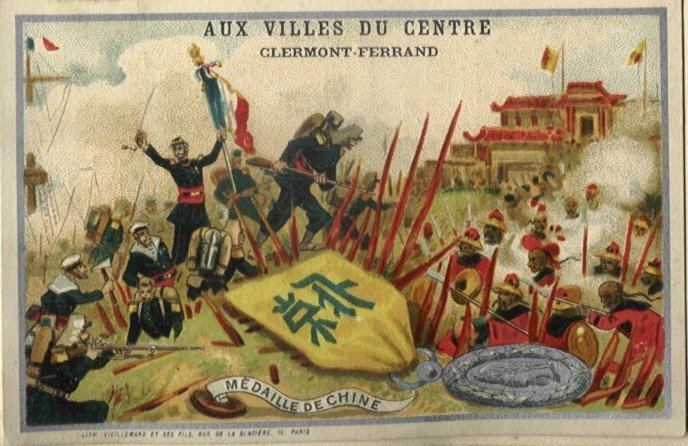Start date 1870 | ||
 | ||
Tianjin massacre
The Tientsin Massacre (Chinese: 天津教案; pinyin: Tiānjīn Jiào'àn; literally: "Tianjin Religion Case"), one of the most important "missionary incidents" of the late Qing dynasty, involved attacks on French Catholic priests and nuns, violent belligerence from French diplomats, and armed foreign intervention in Tianjin (Tientsin) in 1870. The incident marked an end to comparative cooperation between foreign powers and the Tongzhi court, and adversely affected the ongoing renegotiation of the Treaties of Tientsin, first signed in 1858.
Contents
The incident
The presence of foreign influence in Tianjin was not always peaceful; one of the most serious violent incidents to take place was the Tianjin Church Incident In June 1870, rumors spread throughout China concerning Catholic church activities. Catholic nuns had been active in bringing children into their orphanages, sometimes with the inducement of payment to foster families or orphanages which led illicit child-brokers to engage in kidnapping. It was commonly believed that missionaries removed the eyes of unwitting Chinese for use in medicine. Throughout 1870, deaths at these orphanages increased due to outbreaks of disease; the fact that baptism was often given specifically to those likely to die led to the impression a Christian baptism directly resulted in death.
On June 18, three Chinese kidnappers were arrested 30 li outside Tianjin, and while the two eldest were executed almost immediately, the youngest – aged 19 – claimed in public to have sold at least 10 children to the staff and guards of a nearby Catholic orphanage for $6 each.
Chinese officials met with their French counterparts, who had assumed responsibility for the Catholic missions to China since the Arrow War. However, an angry anti-Catholic crowd gathered outside the Cathedral and smashed windows. Chinese Catholic converts begged the French Consul, Henri-Victor Fontanier, to appeal directly to the county magistrate for public calm.
While the Chinese magistrate's staff attempted to suppress the riot, the French Consul visited the magistrate's official quarters to lodge an angry diatribe, even going so far as to draw his sword and embed it in the magistrate's table. The magistrate was not there, however, and Fontanier left empty-handed. The series of events afterwards are somewhat confused: while both Chinese and French histories agree Fontanier shot a Chinese assistant dead after an argument with the magistrate (who was just entering his office as the Consul was leaving), the French version says Fontanier's shot only came after he was threatened by the mob and the magistrate. In any case, both the French Consul and his assistant, M. Simon, were murdered by the rioters and their bodies dumped in the river.
The riot only ended after a number of Catholic institutions and foreign buildings, including the Tientsin Cathedral and four British and American churches, were burned down. As well as the two French Consular officials, two Lazarist priests, and approximately 40 Chinese Christians were killed, as were three Russian traders assumed by the mob to be French. Ten nuns of the Daughters of Charity were raped and mutilated by the crowd before being killed. The final death toll of the riot was given at around 60.
Foreign gunboats were sent to restore order to the legations of Tianjin, with reparations and reprisals demanded by the European governments. Chinese negotiations to mitigate the damage were led by the aging statesman Zeng Guofan. The situation was more complex than Zeng originally thought; he interrogated the orphans, who denied they had been kidnapped, and proclaimed the nuns innocent. However, Europeans were incensed and demanded punishment against the riot's ringleaders. Zeng had eighteen Chinese instigators (or scapegoats, depending on who tells the history) executed and removed both the magistrate and much of his staff. A Chinese mission of apology sailed to France, under Imperial Commissioner Chung How. A formal apology was presented to the provisional French Head of State Adolphe Thiers in November 1871.
The Tientsin Incident was far-reaching politically and culturally. Before 1870 the French and Chinese had been negotiating a clause to bring Western Missionaries under the same guidelines as Chinese Buddhist and Taoist religious institutions, in the hope it would stop such situations as occurred at Tientsin. Afterwards, however, the French and Americans refused to allow Chinese control or protection over the spread of Christianity in the country. The Qing government replied in turn by refusing to either proscribe or endorse foreign missionaries.
For Europeans, the riot and loss of life was further proof that the Chinese government could not be trusted to protect foreigners or their investments. For many Chinese, the fact Europeans and missionaries continued to be an elite outside the realms of Chinese law, and seemingly able to engage in actions through military force without serious repercussions, directly led to anti-foreign feeling which led to the Boxer Rebellion of 1900.
